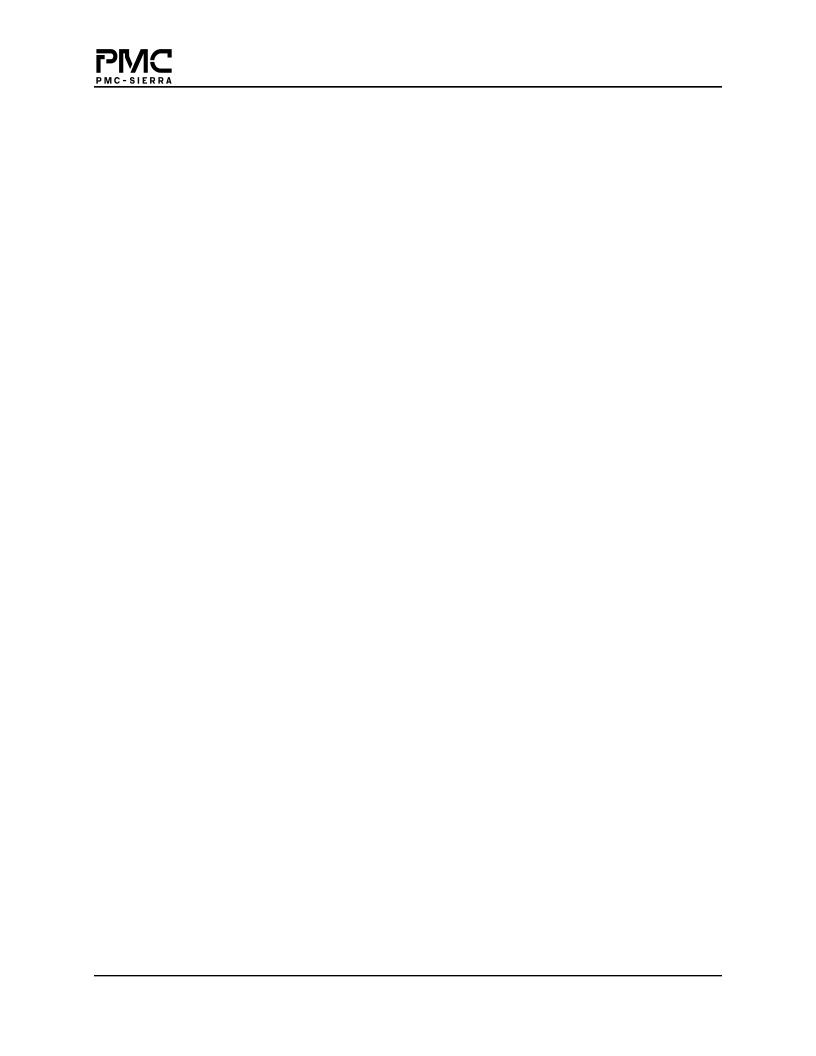- 您現(xiàn)在的位置:買(mǎi)賣(mài)IC網(wǎng) > PDF目錄378055 > PM7347-BI (PMC-SIERRA INC) SATURN USER NETWORK INTERFACE for J2/E3/T3 PDF資料下載
參數(shù)資料
| 型號(hào): | PM7347-BI |
| 廠商: | PMC-SIERRA INC |
| 元件分類(lèi): | 數(shù)字傳輸電路 |
| 英文描述: | SATURN USER NETWORK INTERFACE for J2/E3/T3 |
| 中文描述: | ATM NETWORK INTERFACE, PBGA256 |
| 封裝: | 27 X 27 MM, 1.45 MM HEIGHT, SBGA-256 |
| 文件頁(yè)數(shù): | 72/341頁(yè) |
| 文件大小: | 1861K |
| 代理商: | PM7347-BI |
第1頁(yè)第2頁(yè)第3頁(yè)第4頁(yè)第5頁(yè)第6頁(yè)第7頁(yè)第8頁(yè)第9頁(yè)第10頁(yè)第11頁(yè)第12頁(yè)第13頁(yè)第14頁(yè)第15頁(yè)第16頁(yè)第17頁(yè)第18頁(yè)第19頁(yè)第20頁(yè)第21頁(yè)第22頁(yè)第23頁(yè)第24頁(yè)第25頁(yè)第26頁(yè)第27頁(yè)第28頁(yè)第29頁(yè)第30頁(yè)第31頁(yè)第32頁(yè)第33頁(yè)第34頁(yè)第35頁(yè)第36頁(yè)第37頁(yè)第38頁(yè)第39頁(yè)第40頁(yè)第41頁(yè)第42頁(yè)第43頁(yè)第44頁(yè)第45頁(yè)第46頁(yè)第47頁(yè)第48頁(yè)第49頁(yè)第50頁(yè)第51頁(yè)第52頁(yè)第53頁(yè)第54頁(yè)第55頁(yè)第56頁(yè)第57頁(yè)第58頁(yè)第59頁(yè)第60頁(yè)第61頁(yè)第62頁(yè)第63頁(yè)第64頁(yè)第65頁(yè)第66頁(yè)第67頁(yè)第68頁(yè)第69頁(yè)第70頁(yè)第71頁(yè)當(dāng)前第72頁(yè)第73頁(yè)第74頁(yè)第75頁(yè)第76頁(yè)第77頁(yè)第78頁(yè)第79頁(yè)第80頁(yè)第81頁(yè)第82頁(yè)第83頁(yè)第84頁(yè)第85頁(yè)第86頁(yè)第87頁(yè)第88頁(yè)第89頁(yè)第90頁(yè)第91頁(yè)第92頁(yè)第93頁(yè)第94頁(yè)第95頁(yè)第96頁(yè)第97頁(yè)第98頁(yè)第99頁(yè)第100頁(yè)第101頁(yè)第102頁(yè)第103頁(yè)第104頁(yè)第105頁(yè)第106頁(yè)第107頁(yè)第108頁(yè)第109頁(yè)第110頁(yè)第111頁(yè)第112頁(yè)第113頁(yè)第114頁(yè)第115頁(yè)第116頁(yè)第117頁(yè)第118頁(yè)第119頁(yè)第120頁(yè)第121頁(yè)第122頁(yè)第123頁(yè)第124頁(yè)第125頁(yè)第126頁(yè)第127頁(yè)第128頁(yè)第129頁(yè)第130頁(yè)第131頁(yè)第132頁(yè)第133頁(yè)第134頁(yè)第135頁(yè)第136頁(yè)第137頁(yè)第138頁(yè)第139頁(yè)第140頁(yè)第141頁(yè)第142頁(yè)第143頁(yè)第144頁(yè)第145頁(yè)第146頁(yè)第147頁(yè)第148頁(yè)第149頁(yè)第150頁(yè)第151頁(yè)第152頁(yè)第153頁(yè)第154頁(yè)第155頁(yè)第156頁(yè)第157頁(yè)第158頁(yè)第159頁(yè)第160頁(yè)第161頁(yè)第162頁(yè)第163頁(yè)第164頁(yè)第165頁(yè)第166頁(yè)第167頁(yè)第168頁(yè)第169頁(yè)第170頁(yè)第171頁(yè)第172頁(yè)第173頁(yè)第174頁(yè)第175頁(yè)第176頁(yè)第177頁(yè)第178頁(yè)第179頁(yè)第180頁(yè)第181頁(yè)第182頁(yè)第183頁(yè)第184頁(yè)第185頁(yè)第186頁(yè)第187頁(yè)第188頁(yè)第189頁(yè)第190頁(yè)第191頁(yè)第192頁(yè)第193頁(yè)第194頁(yè)第195頁(yè)第196頁(yè)第197頁(yè)第198頁(yè)第199頁(yè)第200頁(yè)第201頁(yè)第202頁(yè)第203頁(yè)第204頁(yè)第205頁(yè)第206頁(yè)第207頁(yè)第208頁(yè)第209頁(yè)第210頁(yè)第211頁(yè)第212頁(yè)第213頁(yè)第214頁(yè)第215頁(yè)第216頁(yè)第217頁(yè)第218頁(yè)第219頁(yè)第220頁(yè)第221頁(yè)第222頁(yè)第223頁(yè)第224頁(yè)第225頁(yè)第226頁(yè)第227頁(yè)第228頁(yè)第229頁(yè)第230頁(yè)第231頁(yè)第232頁(yè)第233頁(yè)第234頁(yè)第235頁(yè)第236頁(yè)第237頁(yè)第238頁(yè)第239頁(yè)第240頁(yè)第241頁(yè)第242頁(yè)第243頁(yè)第244頁(yè)第245頁(yè)第246頁(yè)第247頁(yè)第248頁(yè)第249頁(yè)第250頁(yè)第251頁(yè)第252頁(yè)第253頁(yè)第254頁(yè)第255頁(yè)第256頁(yè)第257頁(yè)第258頁(yè)第259頁(yè)第260頁(yè)第261頁(yè)第262頁(yè)第263頁(yè)第264頁(yè)第265頁(yè)第266頁(yè)第267頁(yè)第268頁(yè)第269頁(yè)第270頁(yè)第271頁(yè)第272頁(yè)第273頁(yè)第274頁(yè)第275頁(yè)第276頁(yè)第277頁(yè)第278頁(yè)第279頁(yè)第280頁(yè)第281頁(yè)第282頁(yè)第283頁(yè)第284頁(yè)第285頁(yè)第286頁(yè)第287頁(yè)第288頁(yè)第289頁(yè)第290頁(yè)第291頁(yè)第292頁(yè)第293頁(yè)第294頁(yè)第295頁(yè)第296頁(yè)第297頁(yè)第298頁(yè)第299頁(yè)第300頁(yè)第301頁(yè)第302頁(yè)第303頁(yè)第304頁(yè)第305頁(yè)第306頁(yè)第307頁(yè)第308頁(yè)第309頁(yè)第310頁(yè)第311頁(yè)第312頁(yè)第313頁(yè)第314頁(yè)第315頁(yè)第316頁(yè)第317頁(yè)第318頁(yè)第319頁(yè)第320頁(yè)第321頁(yè)第322頁(yè)第323頁(yè)第324頁(yè)第325頁(yè)第326頁(yè)第327頁(yè)第328頁(yè)第329頁(yè)第330頁(yè)第331頁(yè)第332頁(yè)第333頁(yè)第334頁(yè)第335頁(yè)第336頁(yè)第337頁(yè)第338頁(yè)第339頁(yè)第340頁(yè)第341頁(yè)

S/UNI-JET Data Sheet
Released
Proprietary and Confidential to PMC-Sierra, Inc., and for its Customers’ Internal Use
Document ID: PMC-1990267, Issue 3
72
10.16 XBOC Bit Oriented Code Generator
The Bit Oriented Code Generator (XBOC) Block transmits 63 of the possible 64 bit oriented
codes (BOC) in the C-bit parity FEAC channel. A BOC is a 16-bit sequence consisting of eight
ones, a zero, six code bits, and a trailing zero (111111110xxxxxx0) which is repeated as long as
the code is not 111111.
The code to be transmitted is programmed by writing the XBOC Code Register. The 64th code
(111111) is similar to the HDLC idle sequence and is used to disable the transmission of any bit
oriented codes. When transmission is disabled, the FEAC channel is set to all ones.
10.17 TDPR PMDL Transmitter
The Path Maintenance Data Link Transmitter (TDPR) provides a serial data link for the C-bit
parity PMDLin DS3, the serial Network Operator byte or the General Purpose datalink in G.832
E3, the National Use bit datalink in G.751 E3, or the m-bit datalink in J2. The TDPR is used
under microprocessor control to transmit HDLC data frames. It performs all of the data
serialization, CRC generation, zero-bit stuffing, as well as flag, and abort sequence insertion.
Upon completion of the message, a CRC-CCITT FCS can be appended, followed by flags. If the
TDPR transmit data FIFO underflows, an abort sequence is automatically transmitted.
When enabled, the TDPR continuously transmits flags (01111110) until data is ready to be
transmitted. Data bytes to be transmitted are written into the TDPR Transmit Data Register. The
TDPR automatically begins transmission of data once at least one complete packet is written into
its FIFO. All complete packets of data will be transmitted if no error condition occurs. After the
last data byte of a packet, the CRC FCS (if CRC insertion has been enabled) and a flag, or just a
flag (if CRC insertion has not been enabled) is transmitted. The TDPR then returns to the
transmission of flag characters until the next packet is available for transmission. The TDPR will
also force transmission of the FIFO data once the FIFO depth has surpassed the programmable
upper limit threshold.
Transmission commences regardless of whether or not a packet has been completely written into
the FIFO. The user must be careful to avoid overfilling the FIFO. Underruns can only occur if the
packet length is greater than the programmed upper limit threshold because, in such a case,
transmission will begin before a complete packet is stored in the FIFO.
An interrupt can be generated once the FIFO depth has fallen below a user-configured lower
threshold as an indicator for the user to write more data. Interrupts can also be generated if the
FIFO underflows while transmitting a packet when the FIFO is full, or if the FIFO is overrun.
If there are more than five consecutive ones in the raw transmit data or in the CRC data, a zero is
stuffed into the serial data output. This prevents the unintentional transmission of flag or abort
sequences.
相關(guān)PDF資料 |
PDF描述 |
|---|---|
| PM73487-PI | 622 Mbps ATM Traffic Management Device |
| PM73487 | 622 Mbps ATM Traffic Management Device |
| PM73488-PI | 5 Gbit/s ATM Switch Fabric Element |
| PM73488 | 5 Gbit/s ATM Switch Fabric Element |
| PM7349 | Ultraframer DS3/E3/DS2/E2/DS1/E1/DS0 |
相關(guān)代理商/技術(shù)參數(shù) |
參數(shù)描述 |
|---|---|
| PM7347S | 制造商:未知廠家 制造商全稱:未知廠家 功能描述:Telecommunication IC |
| PM73487 | 制造商:PMC 制造商全稱:PMC 功能描述:622 Mbps ATM Traffic Management Device |
| PM73487-PI | 制造商:PMC 制造商全稱:PMC 功能描述:622 Mbps ATM Traffic Management Device |
發(fā)布緊急采購(gòu),3分鐘左右您將得到回復(fù)。